Sustainable Systems Assignment 2: LCA and Energy Efficiency Report
VerifiedAdded on 2023/06/04
|18
|4445
|488
Report
AI Summary
This report presents a comprehensive analysis of Sustainable Systems Assignment 2, focusing on Life Cycle Assessment (LCA) and energy efficiency. The assignment evaluates the environmental impacts of different cup materials, specifically comparing plastic and ceramic cups using the GaBi software. The LCA process includes an executive summary, introduction, GaBi analysis, and conclusions. The analysis considers raw material acquisition, manufacturing, use, and disposal, assessing environmental, economic, and social impacts. The report recommends ceramic cups over plastic, highlighting the release of greenhouse gases and other environmental concerns associated with plastic production. Furthermore, it includes an energy efficiency report, providing a complete overview of the assignment's findings and recommendations. The report utilizes the ISO standards for LCA and provides a detailed methodology and data-driven conclusions. The report also includes references to support the findings.
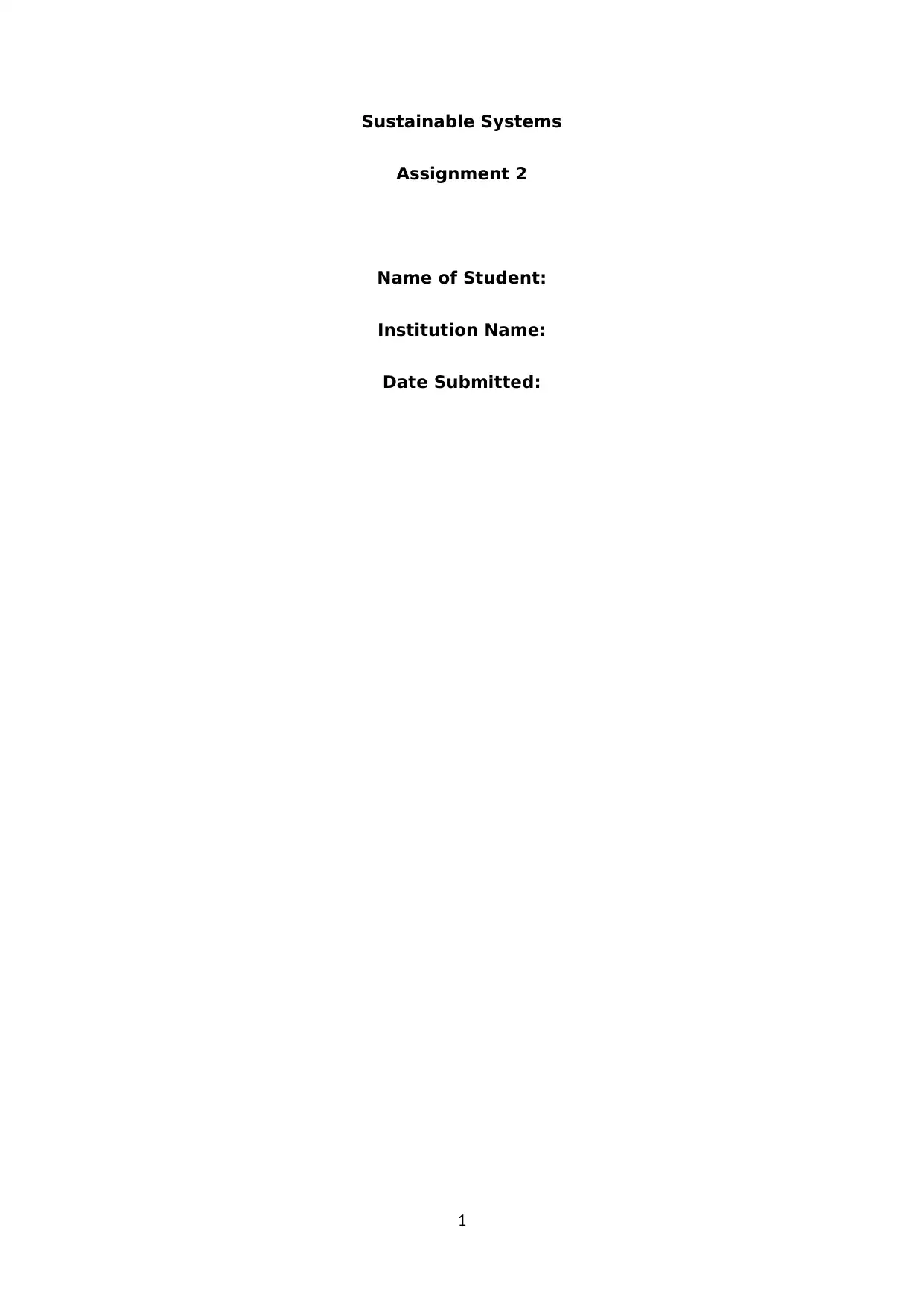
Sustainable Systems
Assignment 2
Name of Student:
Institution Name:
Date Submitted:
1
Assignment 2
Name of Student:
Institution Name:
Date Submitted:
1
Paraphrase This Document
Need a fresh take? Get an instant paraphrase of this document with our AI Paraphraser

Contents
A. LIFE CYCLE ASSESSMENT REPORT.................................................................................................3
Executive Summary..............................................................................................................................3
Introduction..........................................................................................................................................4
GaBi Analysis.........................................................................................................................................6
Conclusions and Recommendations.....................................................................................................9
References..........................................................................................................................................10
B. ENERGY EFFICIENCY REPORT Executive Summary.....................................................................12
Introduction........................................................................................................................................12
Cost Benefit Analysis..........................................................................................................................13
Conclusions and Recommendations...................................................................................................14
References..........................................................................................................................................15
2
A. LIFE CYCLE ASSESSMENT REPORT.................................................................................................3
Executive Summary..............................................................................................................................3
Introduction..........................................................................................................................................4
GaBi Analysis.........................................................................................................................................6
Conclusions and Recommendations.....................................................................................................9
References..........................................................................................................................................10
B. ENERGY EFFICIENCY REPORT Executive Summary.....................................................................12
Introduction........................................................................................................................................12
Cost Benefit Analysis..........................................................................................................................13
Conclusions and Recommendations...................................................................................................14
References..........................................................................................................................................15
2
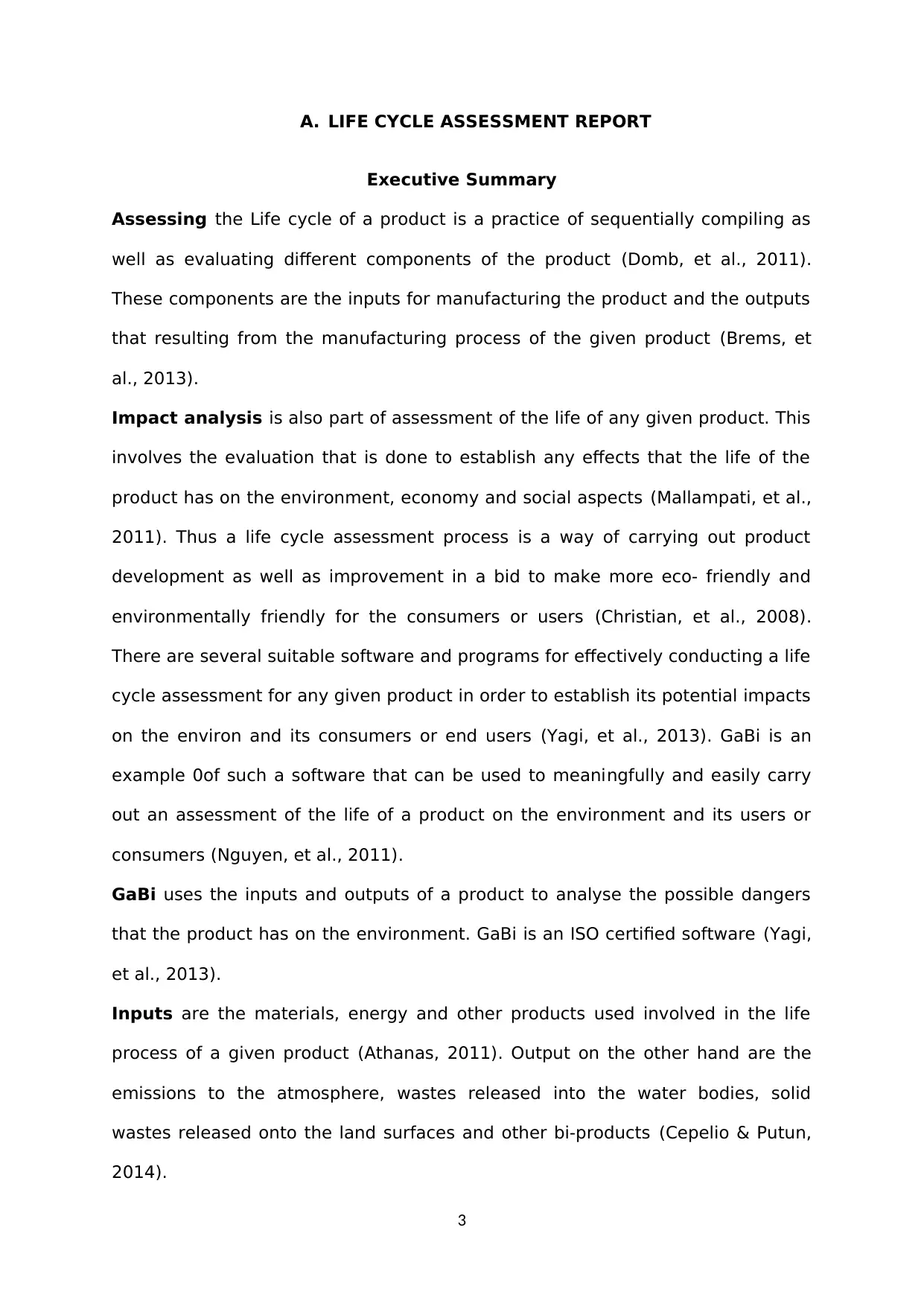
A. LIFE CYCLE ASSESSMENT REPORT
Executive Summary
Assessing the Life cycle of a product is a practice of sequentially compiling as
well as evaluating different components of the product (Domb, et al., 2011).
These components are the inputs for manufacturing the product and the outputs
that resulting from the manufacturing process of the given product (Brems, et
al., 2013).
Impact analysis is also part of assessment of the life of any given product. This
involves the evaluation that is done to establish any effects that the life of the
product has on the environment, economy and social aspects (Mallampati, et al.,
2011). Thus a life cycle assessment process is a way of carrying out product
development as well as improvement in a bid to make more eco- friendly and
environmentally friendly for the consumers or users (Christian, et al., 2008).
There are several suitable software and programs for effectively conducting a life
cycle assessment for any given product in order to establish its potential impacts
on the environ and its consumers or end users (Yagi, et al., 2013). GaBi is an
example 0of such a software that can be used to meaningfully and easily carry
out an assessment of the life of a product on the environment and its users or
consumers (Nguyen, et al., 2011).
GaBi uses the inputs and outputs of a product to analyse the possible dangers
that the product has on the environment. GaBi is an ISO certified software (Yagi,
et al., 2013).
Inputs are the materials, energy and other products used involved in the life
process of a given product (Athanas, 2011). Output on the other hand are the
emissions to the atmosphere, wastes released into the water bodies, solid
wastes released onto the land surfaces and other bi-products (Cepelio & Putun,
2014).
3
Executive Summary
Assessing the Life cycle of a product is a practice of sequentially compiling as
well as evaluating different components of the product (Domb, et al., 2011).
These components are the inputs for manufacturing the product and the outputs
that resulting from the manufacturing process of the given product (Brems, et
al., 2013).
Impact analysis is also part of assessment of the life of any given product. This
involves the evaluation that is done to establish any effects that the life of the
product has on the environment, economy and social aspects (Mallampati, et al.,
2011). Thus a life cycle assessment process is a way of carrying out product
development as well as improvement in a bid to make more eco- friendly and
environmentally friendly for the consumers or users (Christian, et al., 2008).
There are several suitable software and programs for effectively conducting a life
cycle assessment for any given product in order to establish its potential impacts
on the environ and its consumers or end users (Yagi, et al., 2013). GaBi is an
example 0of such a software that can be used to meaningfully and easily carry
out an assessment of the life of a product on the environment and its users or
consumers (Nguyen, et al., 2011).
GaBi uses the inputs and outputs of a product to analyse the possible dangers
that the product has on the environment. GaBi is an ISO certified software (Yagi,
et al., 2013).
Inputs are the materials, energy and other products used involved in the life
process of a given product (Athanas, 2011). Output on the other hand are the
emissions to the atmosphere, wastes released into the water bodies, solid
wastes released onto the land surfaces and other bi-products (Cepelio & Putun,
2014).
3
⊘ This is a preview!⊘
Do you want full access?
Subscribe today to unlock all pages.

Trusted by 1+ million students worldwide
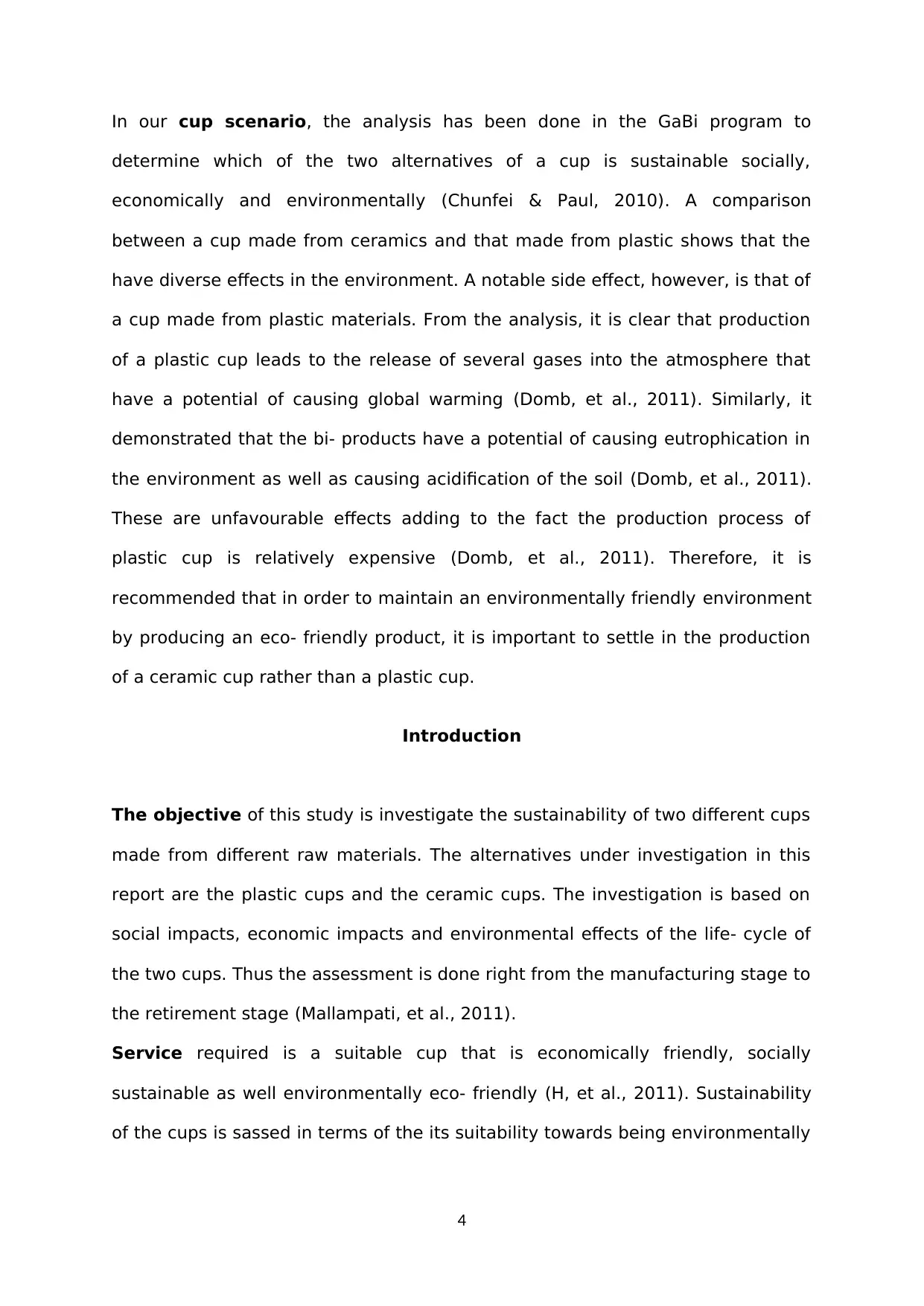
In our cup scenario, the analysis has been done in the GaBi program to
determine which of the two alternatives of a cup is sustainable socially,
economically and environmentally (Chunfei & Paul, 2010). A comparison
between a cup made from ceramics and that made from plastic shows that the
have diverse effects in the environment. A notable side effect, however, is that of
a cup made from plastic materials. From the analysis, it is clear that production
of a plastic cup leads to the release of several gases into the atmosphere that
have a potential of causing global warming (Domb, et al., 2011). Similarly, it
demonstrated that the bi- products have a potential of causing eutrophication in
the environment as well as causing acidification of the soil (Domb, et al., 2011).
These are unfavourable effects adding to the fact the production process of
plastic cup is relatively expensive (Domb, et al., 2011). Therefore, it is
recommended that in order to maintain an environmentally friendly environment
by producing an eco- friendly product, it is important to settle in the production
of a ceramic cup rather than a plastic cup.
Introduction
The objective of this study is investigate the sustainability of two different cups
made from different raw materials. The alternatives under investigation in this
report are the plastic cups and the ceramic cups. The investigation is based on
social impacts, economic impacts and environmental effects of the life- cycle of
the two cups. Thus the assessment is done right from the manufacturing stage to
the retirement stage (Mallampati, et al., 2011).
Service required is a suitable cup that is economically friendly, socially
sustainable as well environmentally eco- friendly (H, et al., 2011). Sustainability
of the cups is sassed in terms of the its suitability towards being environmentally
4
determine which of the two alternatives of a cup is sustainable socially,
economically and environmentally (Chunfei & Paul, 2010). A comparison
between a cup made from ceramics and that made from plastic shows that the
have diverse effects in the environment. A notable side effect, however, is that of
a cup made from plastic materials. From the analysis, it is clear that production
of a plastic cup leads to the release of several gases into the atmosphere that
have a potential of causing global warming (Domb, et al., 2011). Similarly, it
demonstrated that the bi- products have a potential of causing eutrophication in
the environment as well as causing acidification of the soil (Domb, et al., 2011).
These are unfavourable effects adding to the fact the production process of
plastic cup is relatively expensive (Domb, et al., 2011). Therefore, it is
recommended that in order to maintain an environmentally friendly environment
by producing an eco- friendly product, it is important to settle in the production
of a ceramic cup rather than a plastic cup.
Introduction
The objective of this study is investigate the sustainability of two different cups
made from different raw materials. The alternatives under investigation in this
report are the plastic cups and the ceramic cups. The investigation is based on
social impacts, economic impacts and environmental effects of the life- cycle of
the two cups. Thus the assessment is done right from the manufacturing stage to
the retirement stage (Mallampati, et al., 2011).
Service required is a suitable cup that is economically friendly, socially
sustainable as well environmentally eco- friendly (H, et al., 2011). Sustainability
of the cups is sassed in terms of the its suitability towards being environmentally
4
Paraphrase This Document
Need a fresh take? Get an instant paraphrase of this document with our AI Paraphraser

friendly bio- degradable, recyclable, ozone friendly and contribution towards
global warming (Lendlein, et al., 2015)
Alternatives are the ceramic and plastic cups. The life- cycle of these
alternatives have been assessed using a GaBi program. Assessment requires
several stages such as acquisition of raw material, processing of material,
manufacturing and assembly, the uses and services of the products and the
retirement and retirement (Lendlein, et al., 2015). The assessment also involves
the investigation of the possible materials that are re- used, recycled or
remanufactured (Liste, 2011).
Gabi has been used for the life cycle assessment process. GaBi is a program for
conducting life assessment modelling (Nguyen, et al., 2011). According to the
ISO standards, assessment is made up of goal and scope definition, analysis of
inventory, assessment of the impact and interpretation of the results (Olkhov, et
al., 2015). Goal and scope definition involves the analysis off the purpose of the
life cycle analysis and the target audience of the assessment (Oyedun, et al.,
2014). On the other hand, inventory analysis involves very important units of the
assessment, the assessment boundaries and analysis of data assumptions
considered and likewise assessment limitations (Oyedun, et al., 2014). Impact
assessment of the effects of the products life cycle on the environment (Peeters,
et al., 2015).These effects are either atmospheric effects on the social aspect as
well as economic effect (Ruj, et al., 2012).
Recommended procedure International Organization for Standardization have
to be followed in order to successfully assess the cycle in a clear specified
manner (Ruj, et al., 2012). This procedure can be represented in a flow chart as
shown in the diagram below. The flow chart is a brief display of the steps
proposed and supported by ISO for conducting a life cycle assessment
5
global warming (Lendlein, et al., 2015)
Alternatives are the ceramic and plastic cups. The life- cycle of these
alternatives have been assessed using a GaBi program. Assessment requires
several stages such as acquisition of raw material, processing of material,
manufacturing and assembly, the uses and services of the products and the
retirement and retirement (Lendlein, et al., 2015). The assessment also involves
the investigation of the possible materials that are re- used, recycled or
remanufactured (Liste, 2011).
Gabi has been used for the life cycle assessment process. GaBi is a program for
conducting life assessment modelling (Nguyen, et al., 2011). According to the
ISO standards, assessment is made up of goal and scope definition, analysis of
inventory, assessment of the impact and interpretation of the results (Olkhov, et
al., 2015). Goal and scope definition involves the analysis off the purpose of the
life cycle analysis and the target audience of the assessment (Oyedun, et al.,
2014). On the other hand, inventory analysis involves very important units of the
assessment, the assessment boundaries and analysis of data assumptions
considered and likewise assessment limitations (Oyedun, et al., 2014). Impact
assessment of the effects of the products life cycle on the environment (Peeters,
et al., 2015).These effects are either atmospheric effects on the social aspect as
well as economic effect (Ruj, et al., 2012).
Recommended procedure International Organization for Standardization have
to be followed in order to successfully assess the cycle in a clear specified
manner (Ruj, et al., 2012). This procedure can be represented in a flow chart as
shown in the diagram below. The flow chart is a brief display of the steps
proposed and supported by ISO for conducting a life cycle assessment
5
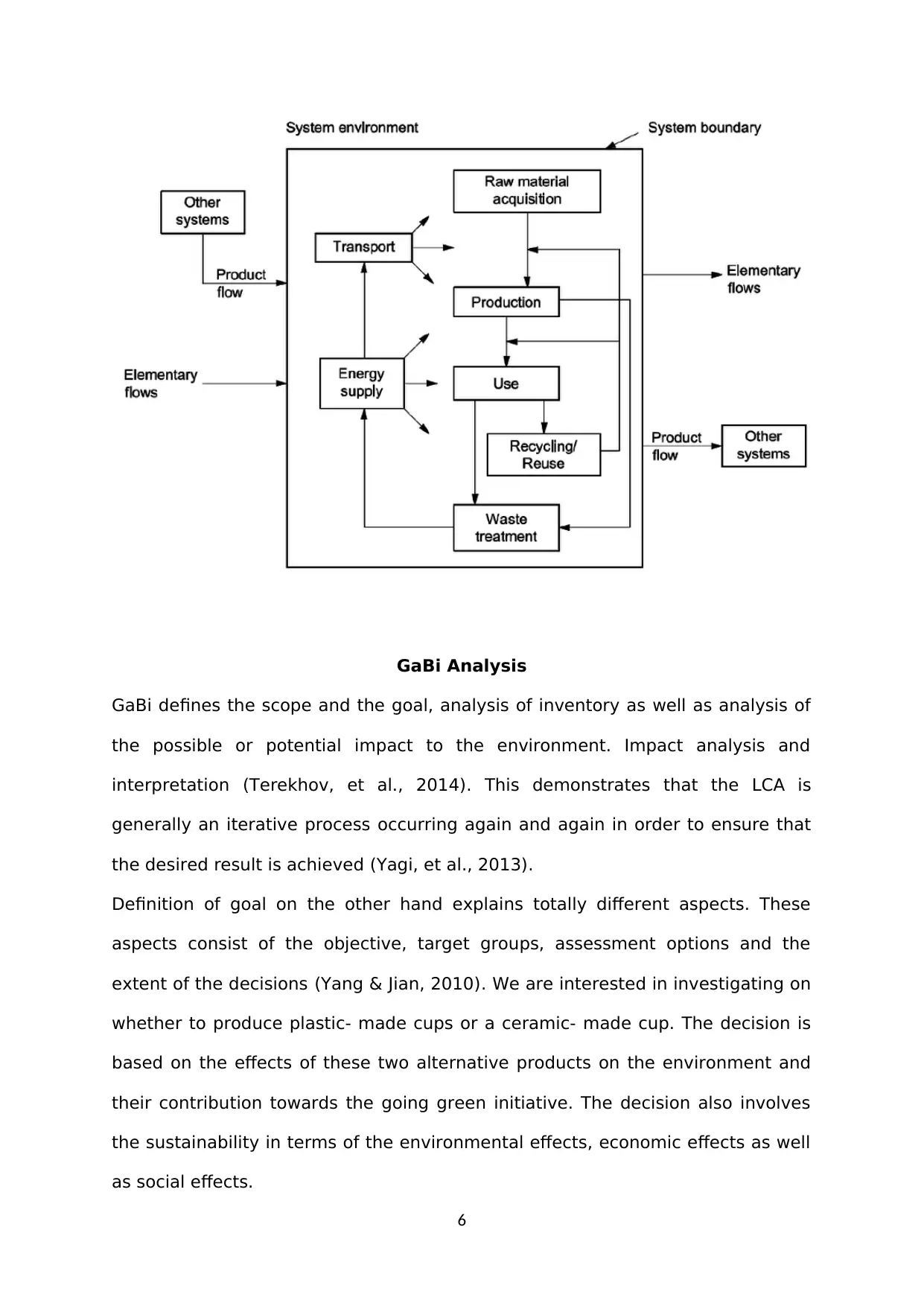
GaBi Analysis
GaBi defines the scope and the goal, analysis of inventory as well as analysis of
the possible or potential impact to the environment. Impact analysis and
interpretation (Terekhov, et al., 2014). This demonstrates that the LCA is
generally an iterative process occurring again and again in order to ensure that
the desired result is achieved (Yagi, et al., 2013).
Definition of goal on the other hand explains totally different aspects. These
aspects consist of the objective, target groups, assessment options and the
extent of the decisions (Yang & Jian, 2010). We are interested in investigating on
whether to produce plastic- made cups or a ceramic- made cup. The decision is
based on the effects of these two alternative products on the environment and
their contribution towards the going green initiative. The decision also involves
the sustainability in terms of the environmental effects, economic effects as well
as social effects.
6
GaBi defines the scope and the goal, analysis of inventory as well as analysis of
the possible or potential impact to the environment. Impact analysis and
interpretation (Terekhov, et al., 2014). This demonstrates that the LCA is
generally an iterative process occurring again and again in order to ensure that
the desired result is achieved (Yagi, et al., 2013).
Definition of goal on the other hand explains totally different aspects. These
aspects consist of the objective, target groups, assessment options and the
extent of the decisions (Yang & Jian, 2010). We are interested in investigating on
whether to produce plastic- made cups or a ceramic- made cup. The decision is
based on the effects of these two alternative products on the environment and
their contribution towards the going green initiative. The decision also involves
the sustainability in terms of the environmental effects, economic effects as well
as social effects.
6
⊘ This is a preview!⊘
Do you want full access?
Subscribe today to unlock all pages.

Trusted by 1+ million students worldwide
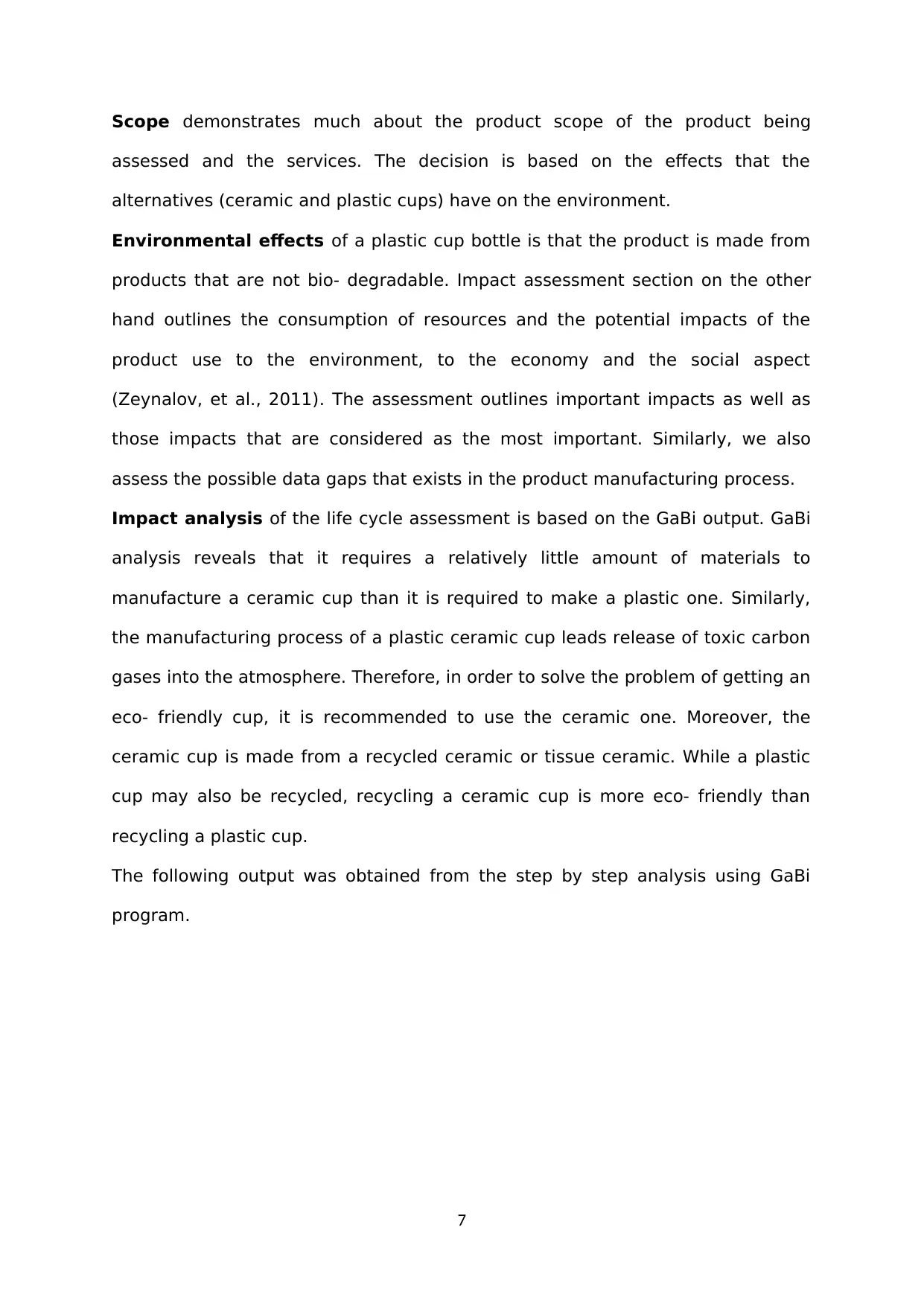
Scope demonstrates much about the product scope of the product being
assessed and the services. The decision is based on the effects that the
alternatives (ceramic and plastic cups) have on the environment.
Environmental effects of a plastic cup bottle is that the product is made from
products that are not bio- degradable. Impact assessment section on the other
hand outlines the consumption of resources and the potential impacts of the
product use to the environment, to the economy and the social aspect
(Zeynalov, et al., 2011). The assessment outlines important impacts as well as
those impacts that are considered as the most important. Similarly, we also
assess the possible data gaps that exists in the product manufacturing process.
Impact analysis of the life cycle assessment is based on the GaBi output. GaBi
analysis reveals that it requires a relatively little amount of materials to
manufacture a ceramic cup than it is required to make a plastic one. Similarly,
the manufacturing process of a plastic ceramic cup leads release of toxic carbon
gases into the atmosphere. Therefore, in order to solve the problem of getting an
eco- friendly cup, it is recommended to use the ceramic one. Moreover, the
ceramic cup is made from a recycled ceramic or tissue ceramic. While a plastic
cup may also be recycled, recycling a ceramic cup is more eco- friendly than
recycling a plastic cup.
The following output was obtained from the step by step analysis using GaBi
program.
7
assessed and the services. The decision is based on the effects that the
alternatives (ceramic and plastic cups) have on the environment.
Environmental effects of a plastic cup bottle is that the product is made from
products that are not bio- degradable. Impact assessment section on the other
hand outlines the consumption of resources and the potential impacts of the
product use to the environment, to the economy and the social aspect
(Zeynalov, et al., 2011). The assessment outlines important impacts as well as
those impacts that are considered as the most important. Similarly, we also
assess the possible data gaps that exists in the product manufacturing process.
Impact analysis of the life cycle assessment is based on the GaBi output. GaBi
analysis reveals that it requires a relatively little amount of materials to
manufacture a ceramic cup than it is required to make a plastic one. Similarly,
the manufacturing process of a plastic ceramic cup leads release of toxic carbon
gases into the atmosphere. Therefore, in order to solve the problem of getting an
eco- friendly cup, it is recommended to use the ceramic one. Moreover, the
ceramic cup is made from a recycled ceramic or tissue ceramic. While a plastic
cup may also be recycled, recycling a ceramic cup is more eco- friendly than
recycling a plastic cup.
The following output was obtained from the step by step analysis using GaBi
program.
7
Paraphrase This Document
Need a fresh take? Get an instant paraphrase of this document with our AI Paraphraser
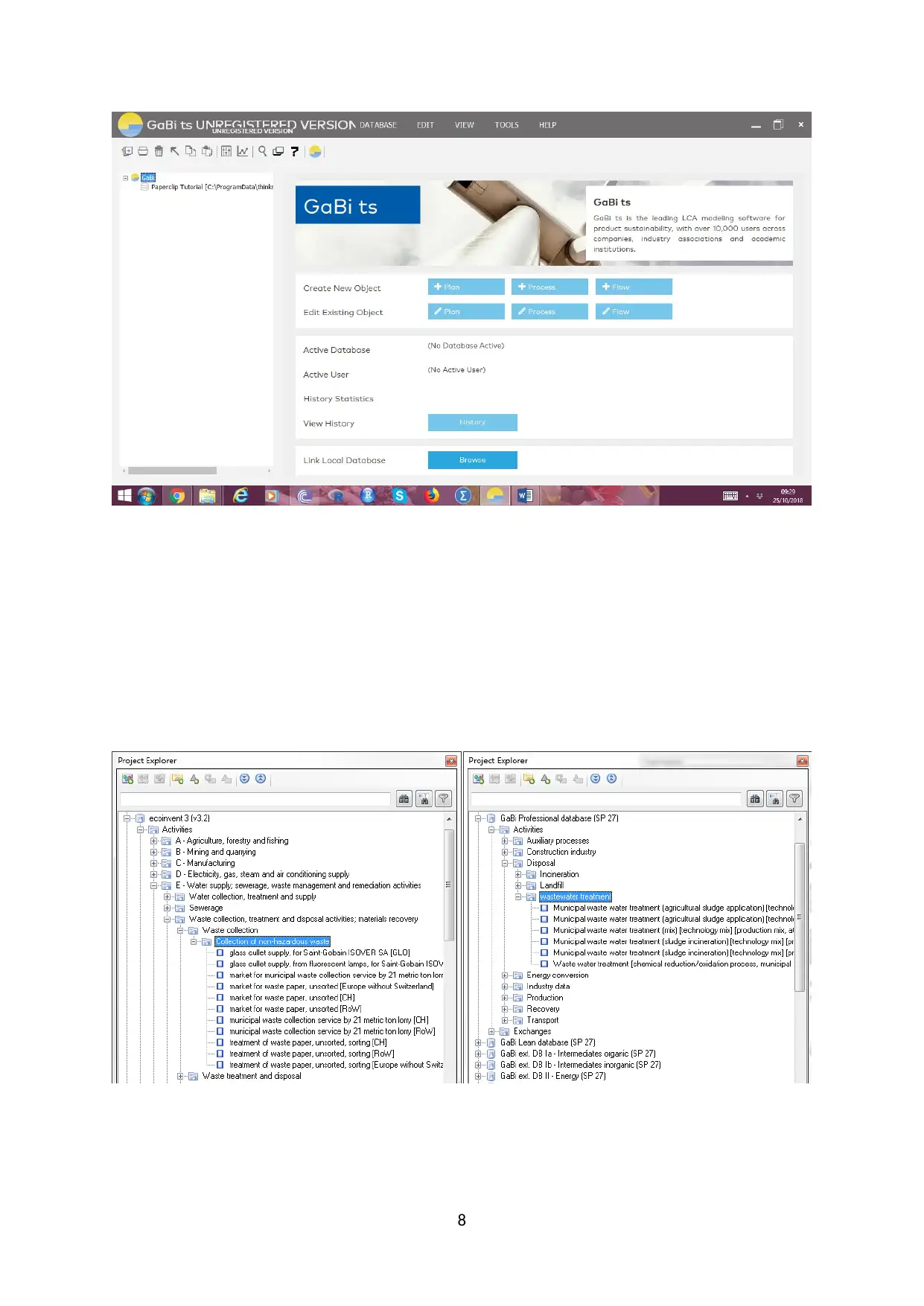
8
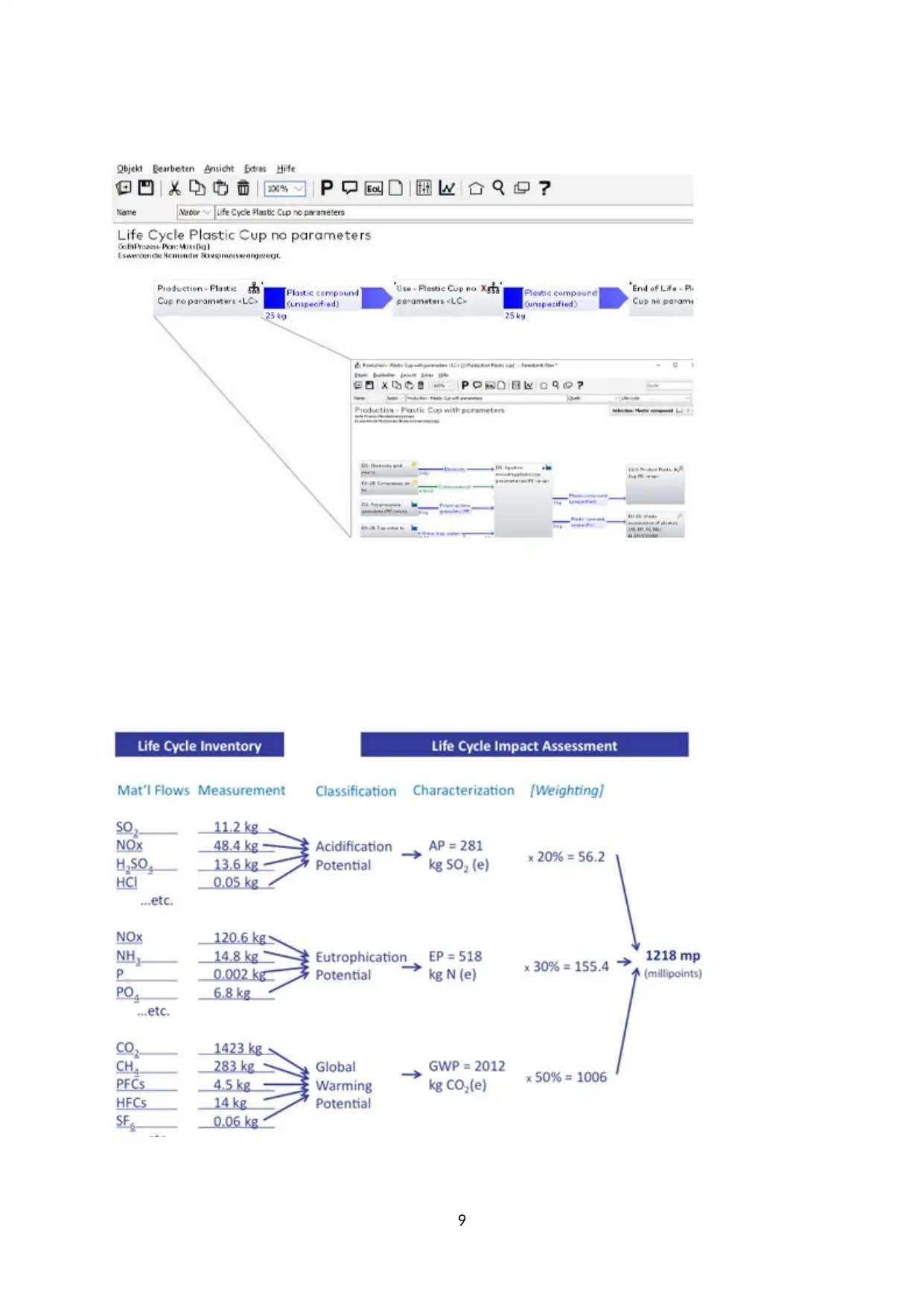
9
⊘ This is a preview!⊘
Do you want full access?
Subscribe today to unlock all pages.

Trusted by 1+ million students worldwide
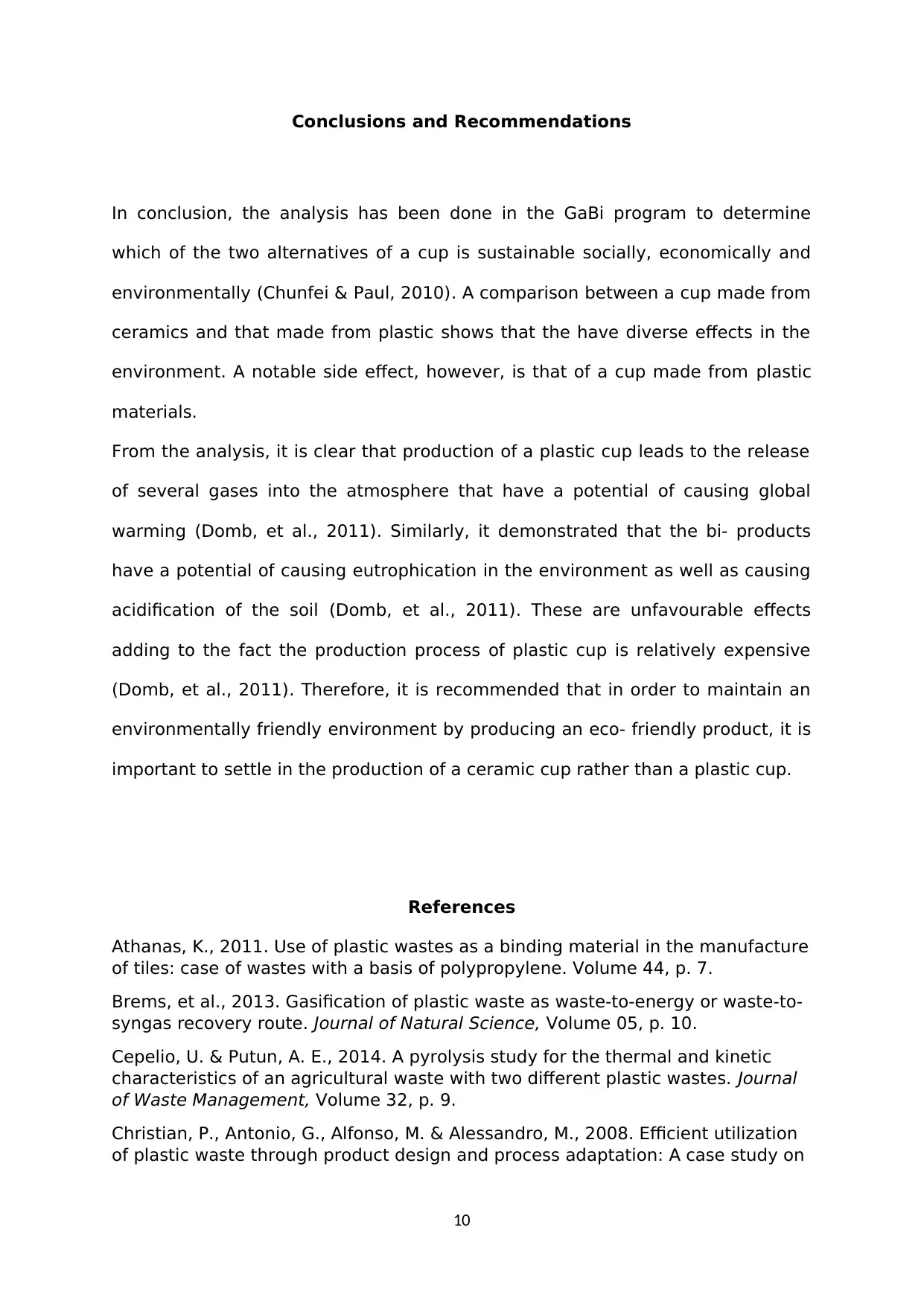
Conclusions and Recommendations
In conclusion, the analysis has been done in the GaBi program to determine
which of the two alternatives of a cup is sustainable socially, economically and
environmentally (Chunfei & Paul, 2010). A comparison between a cup made from
ceramics and that made from plastic shows that the have diverse effects in the
environment. A notable side effect, however, is that of a cup made from plastic
materials.
From the analysis, it is clear that production of a plastic cup leads to the release
of several gases into the atmosphere that have a potential of causing global
warming (Domb, et al., 2011). Similarly, it demonstrated that the bi- products
have a potential of causing eutrophication in the environment as well as causing
acidification of the soil (Domb, et al., 2011). These are unfavourable effects
adding to the fact the production process of plastic cup is relatively expensive
(Domb, et al., 2011). Therefore, it is recommended that in order to maintain an
environmentally friendly environment by producing an eco- friendly product, it is
important to settle in the production of a ceramic cup rather than a plastic cup.
References
Athanas, K., 2011. Use of plastic wastes as a binding material in the manufacture
of tiles: case of wastes with a basis of polypropylene. Volume 44, p. 7.
Brems, et al., 2013. Gasification of plastic waste as waste-to-energy or waste-to-
syngas recovery route. Journal of Natural Science, Volume 05, p. 10.
Cepelio, U. & Putun, A. E., 2014. A pyrolysis study for the thermal and kinetic
characteristics of an agricultural waste with two different plastic wastes. Journal
of Waste Management, Volume 32, p. 9.
Christian, P., Antonio, G., Alfonso, M. & Alessandro, M., 2008. Efficient utilization
of plastic waste through product design and process adaptation: A case study on
10
In conclusion, the analysis has been done in the GaBi program to determine
which of the two alternatives of a cup is sustainable socially, economically and
environmentally (Chunfei & Paul, 2010). A comparison between a cup made from
ceramics and that made from plastic shows that the have diverse effects in the
environment. A notable side effect, however, is that of a cup made from plastic
materials.
From the analysis, it is clear that production of a plastic cup leads to the release
of several gases into the atmosphere that have a potential of causing global
warming (Domb, et al., 2011). Similarly, it demonstrated that the bi- products
have a potential of causing eutrophication in the environment as well as causing
acidification of the soil (Domb, et al., 2011). These are unfavourable effects
adding to the fact the production process of plastic cup is relatively expensive
(Domb, et al., 2011). Therefore, it is recommended that in order to maintain an
environmentally friendly environment by producing an eco- friendly product, it is
important to settle in the production of a ceramic cup rather than a plastic cup.
References
Athanas, K., 2011. Use of plastic wastes as a binding material in the manufacture
of tiles: case of wastes with a basis of polypropylene. Volume 44, p. 7.
Brems, et al., 2013. Gasification of plastic waste as waste-to-energy or waste-to-
syngas recovery route. Journal of Natural Science, Volume 05, p. 10.
Cepelio, U. & Putun, A. E., 2014. A pyrolysis study for the thermal and kinetic
characteristics of an agricultural waste with two different plastic wastes. Journal
of Waste Management, Volume 32, p. 9.
Christian, P., Antonio, G., Alfonso, M. & Alessandro, M., 2008. Efficient utilization
of plastic waste through product design and process adaptation: A case study on
10
Paraphrase This Document
Need a fresh take? Get an instant paraphrase of this document with our AI Paraphraser
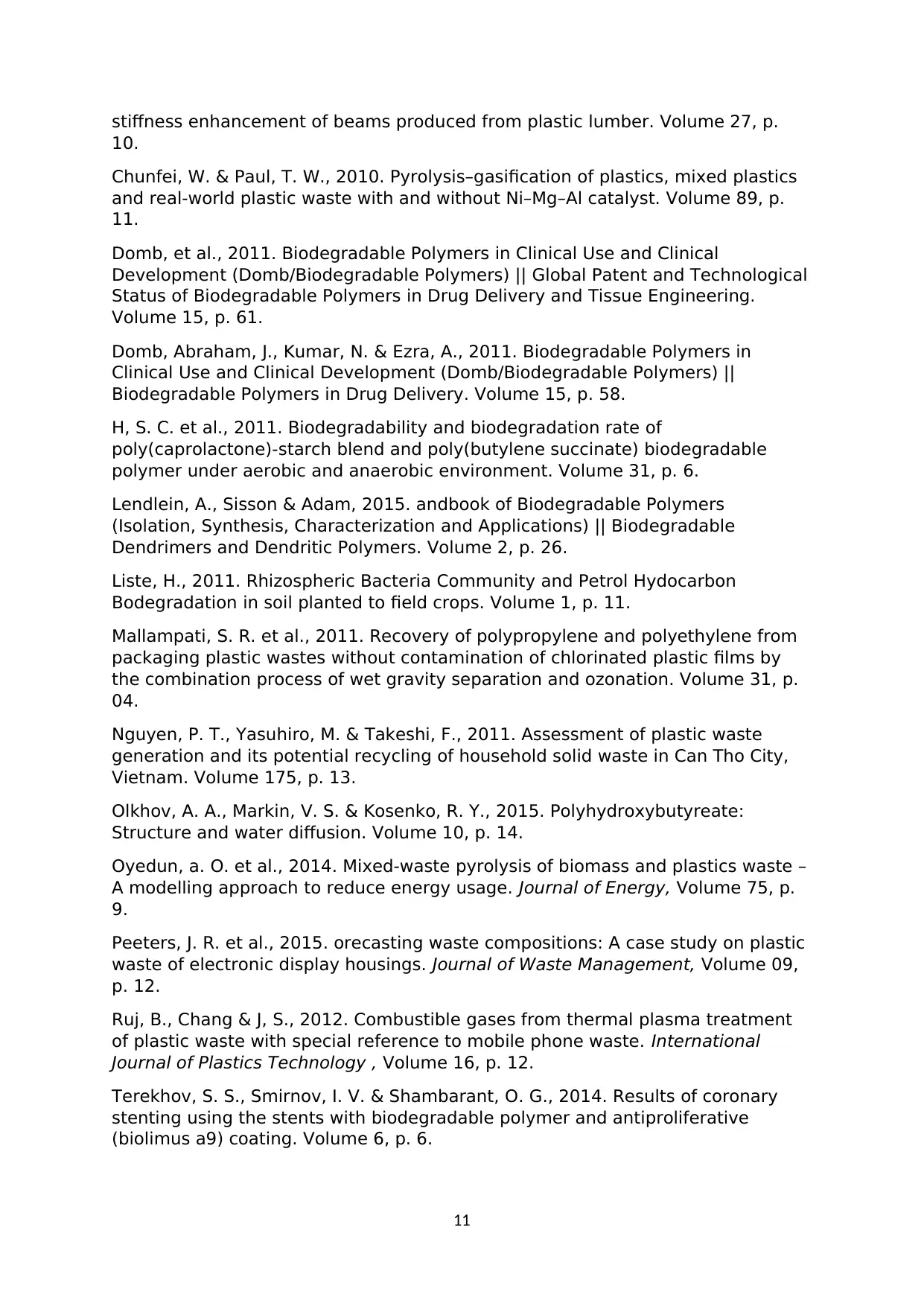
stiffness enhancement of beams produced from plastic lumber. Volume 27, p.
10.
Chunfei, W. & Paul, T. W., 2010. Pyrolysis–gasification of plastics, mixed plastics
and real-world plastic waste with and without Ni–Mg–Al catalyst. Volume 89, p.
11.
Domb, et al., 2011. Biodegradable Polymers in Clinical Use and Clinical
Development (Domb/Biodegradable Polymers) || Global Patent and Technological
Status of Biodegradable Polymers in Drug Delivery and Tissue Engineering.
Volume 15, p. 61.
Domb, Abraham, J., Kumar, N. & Ezra, A., 2011. Biodegradable Polymers in
Clinical Use and Clinical Development (Domb/Biodegradable Polymers) ||
Biodegradable Polymers in Drug Delivery. Volume 15, p. 58.
H, S. C. et al., 2011. Biodegradability and biodegradation rate of
poly(caprolactone)-starch blend and poly(butylene succinate) biodegradable
polymer under aerobic and anaerobic environment. Volume 31, p. 6.
Lendlein, A., Sisson & Adam, 2015. andbook of Biodegradable Polymers
(Isolation, Synthesis, Characterization and Applications) || Biodegradable
Dendrimers and Dendritic Polymers. Volume 2, p. 26.
Liste, H., 2011. Rhizospheric Bacteria Community and Petrol Hydocarbon
Bodegradation in soil planted to field crops. Volume 1, p. 11.
Mallampati, S. R. et al., 2011. Recovery of polypropylene and polyethylene from
packaging plastic wastes without contamination of chlorinated plastic films by
the combination process of wet gravity separation and ozonation. Volume 31, p.
04.
Nguyen, P. T., Yasuhiro, M. & Takeshi, F., 2011. Assessment of plastic waste
generation and its potential recycling of household solid waste in Can Tho City,
Vietnam. Volume 175, p. 13.
Olkhov, A. A., Markin, V. S. & Kosenko, R. Y., 2015. Polyhydroxybutyreate:
Structure and water diffusion. Volume 10, p. 14.
Oyedun, a. O. et al., 2014. Mixed-waste pyrolysis of biomass and plastics waste –
A modelling approach to reduce energy usage. Journal of Energy, Volume 75, p.
9.
Peeters, J. R. et al., 2015. orecasting waste compositions: A case study on plastic
waste of electronic display housings. Journal of Waste Management, Volume 09,
p. 12.
Ruj, B., Chang & J, S., 2012. Combustible gases from thermal plasma treatment
of plastic waste with special reference to mobile phone waste. International
Journal of Plastics Technology , Volume 16, p. 12.
Terekhov, S. S., Smirnov, I. V. & Shambarant, O. G., 2014. Results of coronary
stenting using the stents with biodegradable polymer and antiproliferative
(biolimus a9) coating. Volume 6, p. 6.
11
10.
Chunfei, W. & Paul, T. W., 2010. Pyrolysis–gasification of plastics, mixed plastics
and real-world plastic waste with and without Ni–Mg–Al catalyst. Volume 89, p.
11.
Domb, et al., 2011. Biodegradable Polymers in Clinical Use and Clinical
Development (Domb/Biodegradable Polymers) || Global Patent and Technological
Status of Biodegradable Polymers in Drug Delivery and Tissue Engineering.
Volume 15, p. 61.
Domb, Abraham, J., Kumar, N. & Ezra, A., 2011. Biodegradable Polymers in
Clinical Use and Clinical Development (Domb/Biodegradable Polymers) ||
Biodegradable Polymers in Drug Delivery. Volume 15, p. 58.
H, S. C. et al., 2011. Biodegradability and biodegradation rate of
poly(caprolactone)-starch blend and poly(butylene succinate) biodegradable
polymer under aerobic and anaerobic environment. Volume 31, p. 6.
Lendlein, A., Sisson & Adam, 2015. andbook of Biodegradable Polymers
(Isolation, Synthesis, Characterization and Applications) || Biodegradable
Dendrimers and Dendritic Polymers. Volume 2, p. 26.
Liste, H., 2011. Rhizospheric Bacteria Community and Petrol Hydocarbon
Bodegradation in soil planted to field crops. Volume 1, p. 11.
Mallampati, S. R. et al., 2011. Recovery of polypropylene and polyethylene from
packaging plastic wastes without contamination of chlorinated plastic films by
the combination process of wet gravity separation and ozonation. Volume 31, p.
04.
Nguyen, P. T., Yasuhiro, M. & Takeshi, F., 2011. Assessment of plastic waste
generation and its potential recycling of household solid waste in Can Tho City,
Vietnam. Volume 175, p. 13.
Olkhov, A. A., Markin, V. S. & Kosenko, R. Y., 2015. Polyhydroxybutyreate:
Structure and water diffusion. Volume 10, p. 14.
Oyedun, a. O. et al., 2014. Mixed-waste pyrolysis of biomass and plastics waste –
A modelling approach to reduce energy usage. Journal of Energy, Volume 75, p.
9.
Peeters, J. R. et al., 2015. orecasting waste compositions: A case study on plastic
waste of electronic display housings. Journal of Waste Management, Volume 09,
p. 12.
Ruj, B., Chang & J, S., 2012. Combustible gases from thermal plasma treatment
of plastic waste with special reference to mobile phone waste. International
Journal of Plastics Technology , Volume 16, p. 12.
Terekhov, S. S., Smirnov, I. V. & Shambarant, O. G., 2014. Results of coronary
stenting using the stents with biodegradable polymer and antiproliferative
(biolimus a9) coating. Volume 6, p. 6.
11

Yagi, et al., 2014. Mesophilic anaerobic biodegradation test and analysis of
eubacteria and archaea involved in anaerobic biodegradation of four specified
biodegradable polyesters. Volume 110, p. 6.
Yagi, et al., 2013. Thermophilic anaerobic biodegradation test and analysis of
eubacteria involved in anaerobic biodegradation of four specified biodegradable
polyesters. Volume 98, p. 6.
Yaling, H. et al., 2012. Sustained clinical safety and efficacy of a biodegradable-
polymer coated sirolimus-eluting stent in “real-world” practice: Three-year
outcomes of the CREATE (multi-center registry of EXCEL biodegradable polymer
drug eluting stents) study. Volume 79, p. 6.
Yang, C. Y. & Jian, J., 2010. Recent advances in biodegradation in China: New
microorganisms and pathways, biodegradation engineering, and bioenergy from
pollutant biodegradation. Volume 45, p. 7.
Yu & Long, 2008. Biodegradable Polymer Blends and Composites from
Renewable Resources (Yu/Biodegradable Polymer Blends) || Biodegradable
Blends Based on Microbial Poly(3-Hydroxybutyrate) and Natural Chitosan.
Volume 8, p. 11.
Zeynalov, R., Asadov, D. A. & Matini, M. B., 2011. Results of coronary stenting
using the stents with biodegradable polymer and antiproliferative (biolimus a9)
coating. Volume 09, p. 6.
B. ENERGY EFFICIENCY REPORT
Executive Summary
Energy efficiency is defined as the suitability, effectiveness and sustainability of
energy. Efficiency of energy and energy source could also be measured in terms
12
eubacteria and archaea involved in anaerobic biodegradation of four specified
biodegradable polyesters. Volume 110, p. 6.
Yagi, et al., 2013. Thermophilic anaerobic biodegradation test and analysis of
eubacteria involved in anaerobic biodegradation of four specified biodegradable
polyesters. Volume 98, p. 6.
Yaling, H. et al., 2012. Sustained clinical safety and efficacy of a biodegradable-
polymer coated sirolimus-eluting stent in “real-world” practice: Three-year
outcomes of the CREATE (multi-center registry of EXCEL biodegradable polymer
drug eluting stents) study. Volume 79, p. 6.
Yang, C. Y. & Jian, J., 2010. Recent advances in biodegradation in China: New
microorganisms and pathways, biodegradation engineering, and bioenergy from
pollutant biodegradation. Volume 45, p. 7.
Yu & Long, 2008. Biodegradable Polymer Blends and Composites from
Renewable Resources (Yu/Biodegradable Polymer Blends) || Biodegradable
Blends Based on Microbial Poly(3-Hydroxybutyrate) and Natural Chitosan.
Volume 8, p. 11.
Zeynalov, R., Asadov, D. A. & Matini, M. B., 2011. Results of coronary stenting
using the stents with biodegradable polymer and antiproliferative (biolimus a9)
coating. Volume 09, p. 6.
B. ENERGY EFFICIENCY REPORT
Executive Summary
Energy efficiency is defined as the suitability, effectiveness and sustainability of
energy. Efficiency of energy and energy source could also be measured in terms
12
⊘ This is a preview!⊘
Do you want full access?
Subscribe today to unlock all pages.

Trusted by 1+ million students worldwide
1 out of 18
Related Documents
Your All-in-One AI-Powered Toolkit for Academic Success.
+13062052269
info@desklib.com
Available 24*7 on WhatsApp / Email
![[object Object]](/_next/static/media/star-bottom.7253800d.svg)
Unlock your academic potential
Copyright © 2020–2025 A2Z Services. All Rights Reserved. Developed and managed by ZUCOL.




